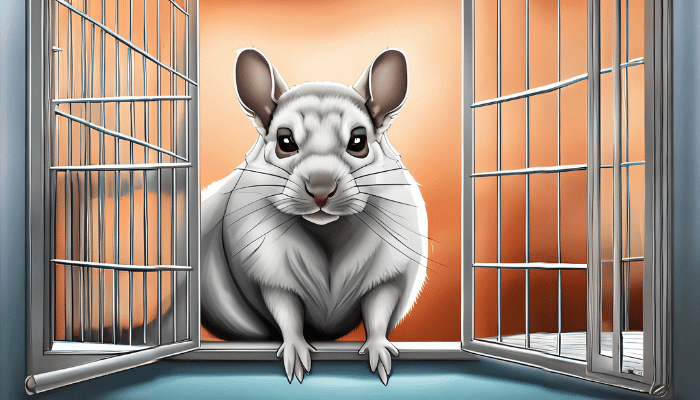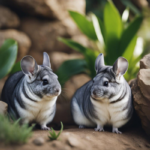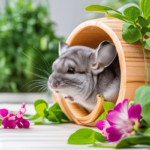Welcome to the ultimate guide on Chinchilla Housing where we explore the ins and outs of providing your adorable, furry companions with the perfect abode. As a chinchilla owner, ensuring a comfortable and stimulating environment is crucial for their well-being.
Let’s delve into the world of Chinchilla Housing and discover how to make your chinchilla’s living space a haven they’ll thrive in.
Why Chinchilla Housing Matters

Before we go into the details, let’s briefly discuss the basic needs of chinchillas when it comes to housing. Chinchillas are not your average pets; they have specific requirements when it comes to their living space. Chinchillas are highly active, social rodents that require spacious, safe, and engaging habitats.
The right housing setup is essential to prevent stress, boredom, and health issues. Understanding why Chinchilla Housing is crucial sets the foundation for creating a sanctuary that promotes their health and happiness.
What Makes Ideal Chinchilla Housing?

Chinchilla housing should incorporate elements that mimic their natural environment, including:
Large Enclosures: Chinchillas thrive in large, multi-level enclosures that cater to their energetic and social nature. These agile rodents benefit from platforms, ramps, and diverse structures that mimic their wild habitat, encouraging activities like climbing and hopping.
Appropriate Bedding: Prioritize chinchilla bedding with safety in mind, opting for hay or aspen shavings to create a cozy and clean living space. These materials ensure respiratory health, with hay also serving as an edible option. Avoid cedar or pine, and maintain a hygienic environment by regularly monitoring and changing the bedding.
Ventilation: Maintaining optimal ventilation is imperative for chinchilla well-being, preventing respiratory problems common in these small rodents. Adequate airflow in their living space helps mitigate the risk of respiratory issues, ensuring a healthy and comfortable environment.
Chew Toys and Accessories: Chinchillas have a natural instinct to chew, making it essential to offer a variety of safe toys and accessories that not only keep them entertained but also contribute to dental health. Providing wooden blocks, lava stones, or other chewable items helps satisfy their chewing instincts, preventing dental issues and promoting overall well-being.
Setting Up the Perfect Chinchilla Home

Now that we understand the essentials, let’s get hands-on with creating the ideal living space for your chinchilla.
Cage Selection
Choosing the right cage is the cornerstone of Chinchilla Housing. Opt for a spacious cage with:
Multi-level Design: Chinchillas thrive in environments that cater to their natural curiosity and love for exploration, making a cage with multiple levels and platforms an ideal living space. This design not only supports their physical activity needs but also provides mental stimulation, creating a dynamic and engaging habitat that enhances their overall well-being.
Bar Spacing: Maintaining the safety of chinchillas is paramount, and choosing a cage with appropriately spaced bars is crucial to prevent escape and injury. Ensuring that the bar spacing is narrow enough is essential, as it prevents these small and agile rodents from squeezing through or getting stuck, contributing to a secure and protective living environment.
Easy Cleaning Features: Opting for cages with easy cleaning features, such as removable trays, streamlines the maintenance of a chinchilla’s living space. This design facilitates hassle-free cleaning by allowing quick removal and cleaning of trays.
Bedding Bliss
When it comes to bedding, prioritize comfort and safety:
Hay Bedding: Incorporating a layer of hay as bedding not only offers a soft and comfortable surface for your chinchilla but also serves as a dual-purpose addition by providing a wholesome snack. Hay is a natural and edible material that encourages foraging behavior, contributing to both the physical and mental well-being of your chinchilla.
Avoid Cedar or Pine Shavings: Choosing to avoid cedar or pine shavings is crucial as they can release harmful aromatic oils, posing a risk to chinchillas’ respiratory systems. These small rodents are particularly sensitive to such irritants.
Chinchilla Proofing Your Space
Chinchillas are curious and agile, so it’s crucial to chinchilla-proof the room they’re housed in:
Hide Cables and Wires: Due to their instinctive nibbling behavior, it’s vital to safeguard chinchillas by hiding cables and wires out of their reach. Chinchillas, curious and prone to chewing, may inadvertently pose a risk to themselves by gnawing on electrical cords. Securing these items ensures a safe environment for these charming and inquisitive rodents.
Chew-Proof Baseboards: Safeguarding baseboards with chew guards is essential to prevent damage caused by the natural chewing behavior of chinchillas. These guards act as a protective barrier, ensuring that the rodents cannot gnaw on or damage the baseboards. This measure not only preserves the aesthetic integrity of the living space but also prevents potential ingestion of harmful materials.
Optimal Cage Placement
Placing your chinchilla’s cage in the right spot is vital for their well-being. Avoid direct sunlight and drafts, as chinchillas are sensitive to temperature fluctuations. A quiet, low-traffic area of your home will help them feel secure.
Create a designated Chinchilla Housing area where they can enjoy a consistent environment without disturbances.
Conclusion
In conclusion, Chinchilla Housing is a multifaceted endeavor that demands attention to detail. From selecting the right cage to maintaining proper nutrition, each aspect plays a crucial role in the overall well-being of your chinchilla.
By investing time and effort into creating an optimal living space, you not only enhance their quality of life but also strengthen the bond between you and your delightful pets.
FAQs

Can I Keep Chinchillas in Small Cages?
No, chinchillas need ample space to move and play. Small cages can lead to stress and health problems.
Can I use a glass aquarium for Chinchilla Housing?
While an aquarium may seem secure, proper ventilation can be an issue. Opt for a well-ventilated metal cage to ensure your chinchilla’s respiratory health.
What temperature is ideal for Chinchilla Housing?
Chinchillas thrive in temperatures between 60-70°F (15-21°C). Avoid extremes, as they are sensitive to heat and cold.
Do chinchillas need companionship?
Chinchillas are social animals and often do better with a companion. Consider adopting a pair to ensure they have company and reduce loneliness.
Can I use cedar or pine bedding?
Avoid cedar and pine bedding, as the aromatic oils can be harmful to chinchillas. Stick to safe options like aspen shavings.
How Often Should I Clean the Chinchilla Cage?
Clean the cage at least once a week, removing soiled bedding and sanitizing the enclosure to ensure a hygienic environment.
Do Chinchillas Need a Dust Bath Inside Their Cage?
Yes, chinchillas need regular dust baths to maintain their fur and skin health. Provide a dust bath container in their cage.
Can Chinchillas Live Together?
Chinchillas are social animals and can thrive in pairs or small groups. However, introduce them gradually to avoid aggression.










